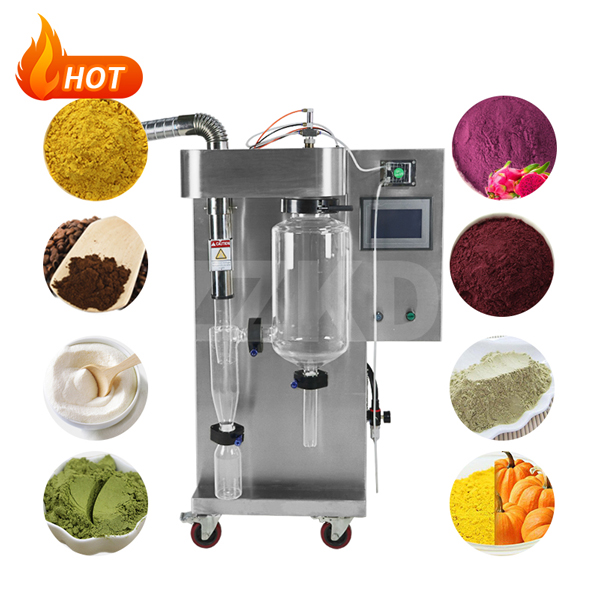Lab Scale Spray Dryer
Our lab scale spray dryers have high borosilicate glass spray dryers. 304 stainless steel spray dryer, centrifugal spray dryer, etc., adopt stainless steel nozzles, with high efficiency and good atomization effect. The lab scale spray dryer is a drying equipment for processing solutions, suspensions or slurry materials. It uses the method of spraying to make the material become mist and disperse in the hot air. The material and the hot air contact each other in the way of co-current, counter-current or mixed flow, so that the water evaporates quickly to achieve the purpose of drying. The lab scale spray dryer adopts this drying method, which can save unit operations such as concentration, filtration, and crushing, and can obtain granular products of 30-500 μm. And the drying time is very short, the general drying time is 5~30s. The lab scale spray dryer is suitable for drying highly heat-sensitive materials and easily dispersed materials in the process of liquid concentration, and the product has good fluidity and instant solubility.

Lab scale spray dryer operating conditions:
1. When connecting the power supply, it must be grounded.
2. Please control the compressed air pressure below 0.3MPa.
3. The outlet temperature of the lab scale spray dryer will cause the deterioration of the suction and exhaust hose materials, filter materials and blast performance. Please do not exceed 100°C. Once it exceeds 110°C, the heater will automatically stop.
4. Please ensure that there is no gap in the setting position of the glass group, and then turn on the blower, heater, etc. after fixing it.
5. Do not use flammable organic solvents in the sample solvent. When using organic solvents, please connect the optional organic solution recovery device.
6. When the heater is on, please do not leave the cap and nozzle socket open for a long time. Be sure to let the wind pass through the heater section. At least, let the air flow rate be 0.1~0.2/min.
7. When the sample cannot be ejected, consider whether the nozzle mesh is blocked, please press the valve core on the nozzle tightly to squeeze out the blocked mesh. When the sample on the tip of the nozzle is attached like an icicle, shake off the sample with the pulse jet switch on the touch screen.
8. When the liquid inlet pump cannot deliver the sample, please check whether the roller part of the pump has not completely flattened the sampling hose, whether the inner wall of the hose is stuck together and has not returned to its original shape, or the inner nozzle is blocked, etc. and then run again.

9. Do not run the lab scale spray dryer when no one is around. When the sample is used up, idling and nozzle clogging will cause the outlet temperature to rise, and the sample hose will slip out of the nozzle, causing the sample to flow out, etc., resulting in unexpected accidents.
10. If it is a silicone hose, it is easy to be corroded by halogen solvents and acids (concentrated), causing expansion and breakage, so be careful when handling it.
11. When the inlet air temperature is set to high temperature, if the air volume of the blower is too large, the set temperature may not be reached due to the capacity of the heater. At this time, either reduce the air volume to run, or increase the set temperature to run. When the set temperature rises, the set value is inconsistent with the actual inlet air temperature. And, when the inlet temperature exceeds 230°C or the outlet temperature exceeds 110°C, the heater stops automatically. When not in use, turn off the leakage protection switch on the right side of the device.
12. Static electricity may be easily generated in the cyclone separator depending on the sample used, operating environment and conditions. Install the supplied ground terminal on the clip on the connection part of the cyclone, or install the static elimination brush on the main body of the cyclone.
13. If there is an air leak between the product container and the lower metal cover of the cyclone separator, the dry powder will accumulate in the lower part of the cyclone separator and may not fall into the product container. Be careful when installing the product container.
14. Since the volume of the product container is about 750mL, the general powder is about 200~250g, accounting for about 80% of its volume. If you continue to run, the powder collection efficiency will be reduced. The operation should be stopped first, and the collected powder should be removed.
15. Due to different samples, the cyclone part is prone to static electricity, please use a suitable method to remove it. Wrap a wire around the glass part. Although the grounding effect is obvious, it is more convenient to touch the cyclone vertically with the static eliminator.


